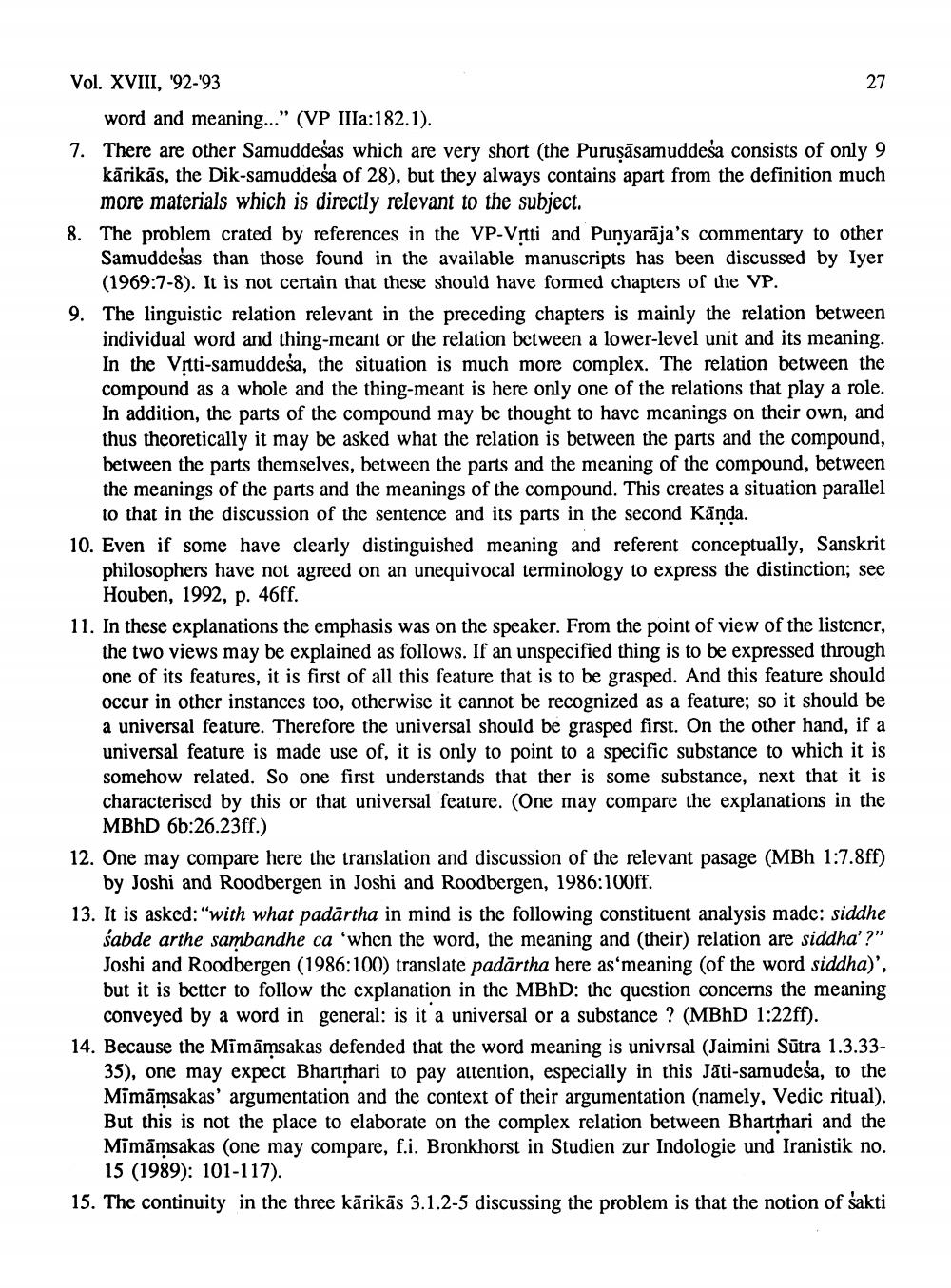________________
Vol. XVIII, '92-'93
word and meaning..." (VP IIIa:182.1). 7. There are other Samuddešas which are very short (the Puruşāsamuddesa consists of only 9
kārikās, the Dik-samuddesa of 28), but they always contains apart from the definition much
more materials which is directly relevant to the subject. 8. The problem crated by references in the VP-Vrtti and Punyarāja's commentary to other
Samuddesas than those found in the available manuscripts has been discussed by Iyer
(1969:7-8). It is not certain that these should have formed chapters of the VP. 9. The linguistic relation relevant in the preceding chapters is mainly the relation between
individual word and thing-meant or the relation between a lower-level unit and its meaning. In the Vrtti-samuddesa, the situation is much more complex. The relation between the compound as a whole and the thing-meant is here only one of the relations that play a role. In addition, the parts of the compound may be thought to have meanings on their own, and thus theoretically it may be asked what the relation is between the parts and the compound, between the parts themselves, between the parts and the meaning of the compound, between the meanings of the parts and the meanings of the compound. This creates a situation parallel
to that in the discussion of the sentence and its parts in the second Kānda. 10. Even if some have clearly distinguished meaning and referent conceptually, Sanskrit
philosophers have not agreed on an unequivocal terminology to express the distinction; see
Houben, 1992, p. 46ff. 11. In these explanations the emphasis was on the speaker. From the point of view of the listener,
the two views may be explained as follows. If an unspecified thing is to be expressed through one of its features, it is first of all this feature that is to be grasped. And this feature should occur in other instances too, otherwise it cannot be recognized as a feature; so it should be a universal feature. Therefore the universal should be grasped first. On the other hand, if a universal feature is made use of, it is only to point to a specific substance to which it is somehow related. So one first understands that ther is some substance, next that it is characterised by this or that universal feature. (One may compare the explanations in the
MBHD 66:26.23ff.) 12. One may compare here the translation and discussion of the relevant pasage (MBh 1:7.8ff)
by Joshi and Roodbergen in Joshi and Roodbergen, 1986:100ff. 13. It is asked: "with what padārtha in mind is the following constituent analysis made: siddhe
śabde arthe sambandhe ca 'when the word, the meaning and (their) relation are siddha'?" Joshi and Roodbergen (1986:100) translate padārtha here as meaning (of the word siddha)', but it is better to follow the explanation in the MBHD: the question concerns the meaning
conveyed by a word in general: is it a universal or a substance ? (MBHD 1:22ff). 14. Because the Mimāmsakas defended that the word meaning is univrsal (Jaimini Sūtra 1.3.33
35), one may expect Bhartqari to pay attention, especially in this Jāti-samudesa, to the Mimāmsakas' argumentation and the context of their argumentation (namely, Vedic ritual). But this is not the place to elaborate on the complex relation between Bhartsari and the Mimāmsakas (one may compare, f.i. Bronkhorst in Studien zur Indologie und Iranistik no.
15 (1989): 101-117). 15. The continuity in the three kārikās 3.1.2-5 discussing the problem is that the notion of sakti




